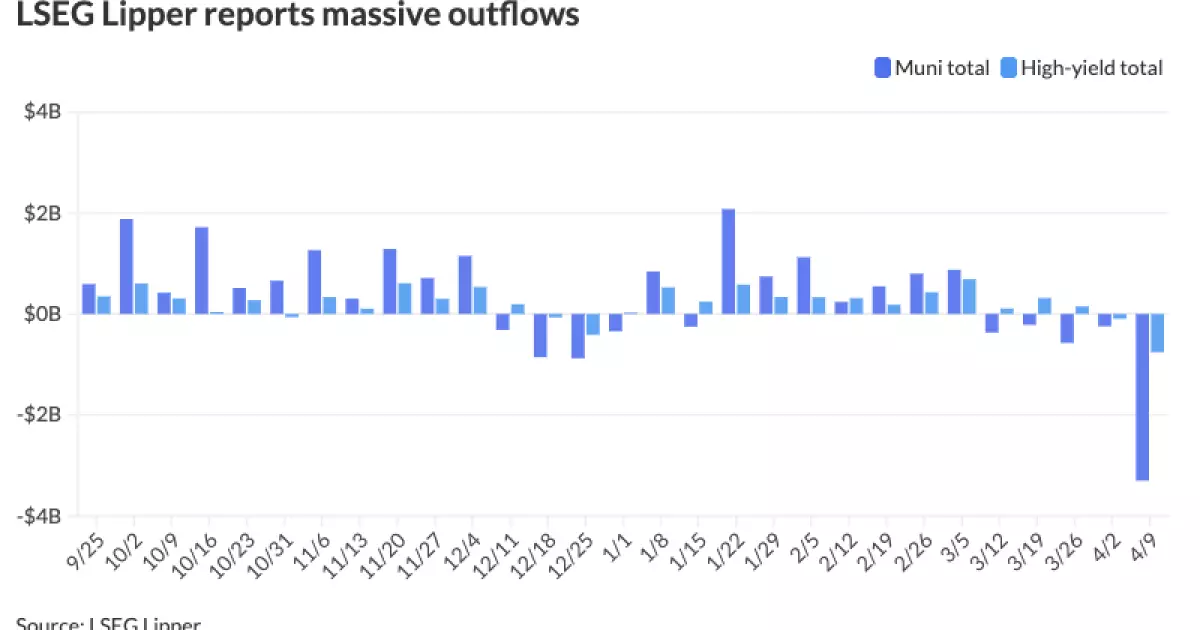Recently, municipal bonds experienced a dramatic shift, with record outflows that speak volumes about market sentiment and investor behavior. Over the past week, municipal bond mutual funds faced withdrawals totaling a staggering $3.3 billion—the highest figure since June 2022. These trends send a stark message: even with the municipal market seeing signs of recovery following Wednesday’s losses, the underlying anxiety persists among investors. Exchange-traded funds reflecting similar strains experienced their largest outflows since reporting began. If anything, this paints a clear picture of how fragile current market conditions can be.
The financial landscape appears ridden with uncertainty, especially with U.S. Treasury yields rising amid escalated tensions between the United States and China. When looking to the future, one must consider whether the recent tariff extensions and the unexpectedly favorable consumer price index (CPI) figures will be sufficient to stabilize investor confidence. History suggests that fleeting gains like these often feel superficial in the face of a greater risk—making such a volatile context even trickier.
Understanding Inflation Signals
It’s important to unpack the implications of lower CPI data. The recent report showed a 2.4% year-over-year increase, falling short of the anticipated hike of 2.6%. While this might initially seem like good news, market analyst Mark Paris of Invesco indicates that investors are treading carefully. Given that inflation has long been a thorn in the side of economic policy, any sign of its persistence or resurgence could lead to dire market consequences.
Pietronico, CEO of Miller Tabak Asset Management, suggests that despite the positive CPI numbers, the broader trend remains filled with uncertainty. “You’re going to continue to see price volatility,” he warns. While some market players may be finding their footing, one cannot disregard potential yield shocks looming on the horizon. The sense of optimism that inflation may have eased must be tempered by the reality that such sentiment can change on a dime.
Debt Supply and Political Winds
Municipal bonds are also being affected by another complicating factor—the historically high supply of new debt hitting the market. The ebb and flow of demand and supply have been jittery even before the heightened volatility experienced this past week. As Tom Murphy from Morningstar’s fixed income team points out, inflows into municipal funds had already begun tapering in March, indicating a shift in investor appetite well ahead of last week’s market dynamics.
To exacerbate conditions, the ongoing debates around tax policies in Washington D.C. further cloud the market. Uncertainty surrounding regulations puts additional strain on bond demand, leading to a further erosion of investor confidence. It’s a tricky balancing act; during times of economic pressure, one would expect investors to flock to the safety of municipal bonds, yet the current climate shows those bonds increasingly seen as risky.
A Game of Market Sentiment
The observed outflows from municipal funds seem to reflect a broader crisis of confidence. The reluctance to invest further is palpable, and it leads to an essential question: can municipal bonds still be considered a safe haven in turbulent times? Market sentiment tilts terrorizingly towards caution, as evidenced by the palpable fear permeating through reports of days filled with significant outflows.
The fact that all categories of municipal funds registered outflows is particularly telling. Not only were high-yield bonds impacted, but also long-term and investment-grade funds saw significant withdrawals. This suggests a widespread retreat from risk across various investor demographics. While ongoing support from regulatory discussions might provide short-term respite, a genuine recovery remains somewhat contingent on macroeconomic stability.
Future Market Dynamics
What should investors expect moving forward in this tumultuous environment? Analysts agree that the path ahead feels unpredictable, with potential volatility looming large. Pietronico suggests that upcoming discussions concerning tariffs may influence market performance over the next few months.
Volatility seems to be the name of the game, and while municipal bonds might look appealing in theory, the practical realities paint a different picture. A 90-day tariff pause may calm fears temporarily, yet the lingering undercurrents of doubt can lead to sudden and steep shifts that investors must remain vigilant towards. In essence, the market stands at a precarious juncture, with even slight economic missteps capable of sending shockwaves throughout the financial ecosystem.
In a landscape where confidence is so easily shaken, one thing remains certain: the outcome of ongoing political machinations and economic strategies will determine whether the municipal bond market can restore its reputation as a safe harbor or be relegated to uncertain waters, forever altered by the winds of change.

